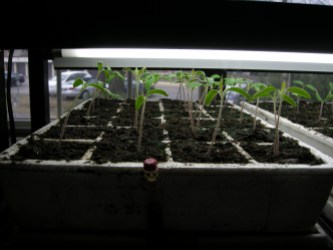Human beings by their very nature are a curious race of people. We are all striving to learn new things, to expand our skill, knowledge, and the reach of our minds. Yet all too often, when it comes to certain topics, we become mired in limited thinking. When it comes to gardening, for example, many of us still think of gardening as a spring, summer, and early fall activity. We plant our seeds and seedlings in the spring, cultivate them in the summer, harvest them in the fall, and spend the winter dreaming about when we can be outside in our gardens once again.
But it doesn’t have to be this way. Through the technique of succession planting, we can garden nearly all year long. How, you ask? Well, I’ll show you with a rough plan. Feel free to take what I’ve given you and modify it for your own allotment (to use the British term).
Late winter/early spring – In late February/early March, purchase seeds of cool season crops – lettuce, arugula, gourmet greens — brassicas (broccoli, cauliflower, kohlrabi, kale, mustard, etc.), peas, and others. Start these indoors under grow lights. You can also get an early start on your tomatoes by starting them indoors under your grow lights. I usually start mine around the first week of spring. Meanwhile, when the first decent weather day comes along, prepare the soil in your garden by working in some compost, earthworm castings, organic fertilizer, and any other soil amendments that you feel is needed. If you did all that the previous fall, then you should already have loose, rich, fertile and friable soil all ready to go. Lay down mulch now to reduce or eliminate your weeding chores later. When the seedlings that you’ve started indoors are big enough, transplant them into your garden. You can protect them from extreme temperatures by surrounding them with a season extending device – bell cloches, Walls O’Water, cold frames, etc. If a frost should occur, your plants should be safe. Besides, a little frost actually improves the flavor of kale.
You can also prepare your garden for an early start for tomatoes and any other crops by digging the holes where you want to plant them and surrounding them with a season-extending device. This will warm up the soil and get it ready to receive those tomato seedlings.
Mid-spring – Keep the spring crops well-watered and well-fed. If you are using a cold frame, make sure that you vent it on warm days, otherwise the heat trapped inside might burn up your plants. Get an early start on your summer crops (corn, cucumber, eggplant, squash, sorghum, muskmelon, watermelon, etc.) by starting these indoors under your grow lights. The tomato seedlings you started should be mature enough to plant in the holes that you’ve surrounded with season extenders.
Late spring/early summer – By now the weather is beginning to get quite warm. Harvest all the lettuce before it bolts (produces a flower), mustard before it becomes pungent, and all of the remaining spring crops before it gets too hot. Memorial Day weekend will be a good time to transplant the summer crops that you started indoors in mid-spring.
Mid-summer – Keep all vegetable plants well-watered and well-fed. Start planning for fall by starting fall crops indoors. Many of the same vegetables you planted in the spring also work well as fall crops. In addition, this is also a good time to start root vegetables (turnip, rutabaga, parsnip, leek, carrot, etc.).
Late summer/early fall – Begin pulling up the remaining summer vegetables and clear space for fall crops. Transplant the fall vegetables from your seed starters indoors to your garden.
Mid fall – Pull up the remaining summer vegetables and start cleaning up the spent plants and other garden debris. Be careful not to damage your fall crops. This is also a great time to plant garlic and onions for next summer’s harvest. Be sure to clean and store all tools, hoses, etc.
Late fall/early winter – Clean up any remaining summer garden debris and begin harvesting your fall vegetables. If you wish, leave a few root crops in the ground for winter usage.
Mid-winter – Do you have a hankering for parsnip-leek soup? Clever you – you left a few parsnips and leeks to overwinter in your garden, and now you don’t have to waste gas, time, and wear and tear on your car to get them. Just put on a coat, walk a few steps into your backyard, and harvest what you need. (Note: if you live with others, please be mindful of your choice of words. Say, “I’m going out in the garden to dig up a few root vegetables.” Don’t say, “I’m going out in the garden to take a leek.”)
Remember also that you can preserve some of your harvest through canning, freezing, drying and cold storage, giving you additional supplies of the good stuff that you can enjoy all year round.
And there you have it. A simple succession planting plan. Done correctly, it will give you wholesome, nutritious, home-grown garden vegetables practically all year round.

